
- Quality Circles (QC) were developed in Japan after the Second World War as a way of revitalising their industry. Their success means that they are now used all around the world as a way of making improvements in the workplace.
- The essential idea of a QC is a group of people who do the same or similar work meeting together to identify, analyse and solve problems in their work and, where possible, implementing solutions.
- The concept of Quality Circles can be used when supporting children with emotional and behavioural difficulties. Essentially it means the adults, usually the staff team (but it can include the parents) working together to develop strategies to help the child.
- It is the interaction between the adults that gives the power to the Quality Circle.

QCs are based on a three-stage problem solving cycle.
The "circle" refers not only to the team of people working together but
also to the cyclical process:
- Stage 1: What is the problem?
- Stage 2: How can we address it?
- Stage 3: Signing up to a plan (expecting change).
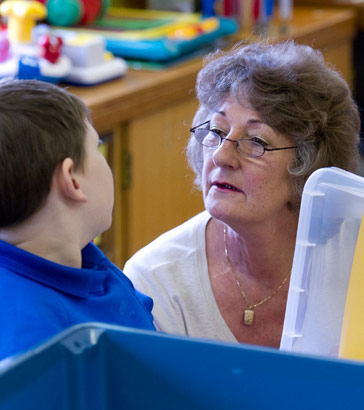
In this section, the stages are illustrated through the case study of Nick, a boy of five who recently started at the school. He is diagnosed as having severe learning difficulties and autism, as well as complex health needs. You will already know something about Nick if you studied material at Level B or earlier sections at Level C.
Work in a small group with your class team.
Select a child whose emotional and behavioural development you are concerned about.
Follow the stages in this package illustrated by Nick and at the same time complete the same stages for the child you have selected.

- At this stage the staff team decides on the priority concern is that they want to address. Usually there is a range of issues of concern but it is important that the team makes a specific commitment to work on only one of them at time.
- The team discusses all the child's difficulties before finally deciding on a priority concern. This discussion is important emotionally and should not be circumvented by someone, e.g. a senior member of staff, making the decision for the team.
- The next activity offers a means for you to organise this first stage with your staff team. It ensures that each member of the team has the opportunity to express what they find of concern before a vote is taken. This prevents one vocally dominant or senior member of staff deciding on the priority area for the staff team.

Give three or four sticky notes to each member of the class team.
Ask each member of the team to write a word or phrase on each sticky note which describes their concerns about the child.
Put the notes up on
a board.
As you are doing this, ask the staff member to elaborate on what they have
written if it is not clear.
Group the post-it notes
into themes.
Once all the themes are identified, vote on which behaviour people would
like to start working on first.
First choice gets 3 points, second choice gets 2 points and third choice
gets one point.
The theme with the most points becomes the priority to work on.

The priority concerns about Nick's behaviour were:
Screaming
and
crying
Only
eating
crisps
Slapping
and
hair pulling
Lack of
participation
in activities
The class team thought that Nick was emotionally distressed. He was non-verbal
and had no means to communicate apart from showing his emotional distress
to the class team. The fact that he would only eat crisps in school was
also extremely difficult for them to deal with.
His complex health needs and his refusal to eat caused the class team considerable
emotional distress as well.
The class team decided that the priority was to focus on Nick's screaming
and crying.
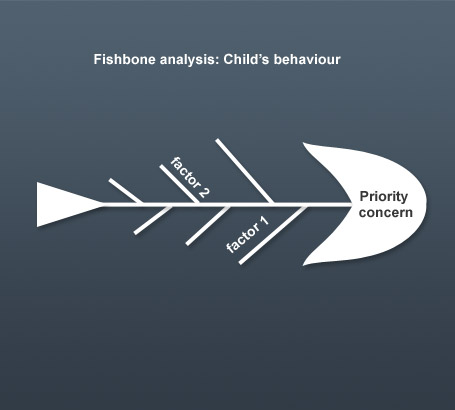
Complete a 'fishbone' for the child you have identified.
Draw a fishbone on a large sheet of paper.
Put the priority concern in the 'head' and then draw and label the spines with the areas that you think might affect the child's behaviour.
Now discuss each factor and as ideas are generated, write them on the fishbone.

- Completing a Fishbone highlights the range of factors that can influence the child's behaviour.
- The team will begin to identify how things at home, in the classroom, and their own behaviour, can influence the child's behaviour.
- Completing the Fishbone can make the team feel dispirited as you will be faced with the full range of factors that may have an influence. However, at a later stage it becomes empowering as you begin to realise that there are many things that can be changed to make a difference.
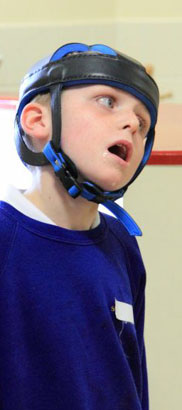
The final part of clarifying the problem is to discuss what the child's explanations of his/her behaviour would be if he or she could communicate effectively.
Ask the group:
"If ... could talk, why would she/he say he/she was upset"
(or whatever the particular concern is)?
The staff group are likely to generate a number of reasons.
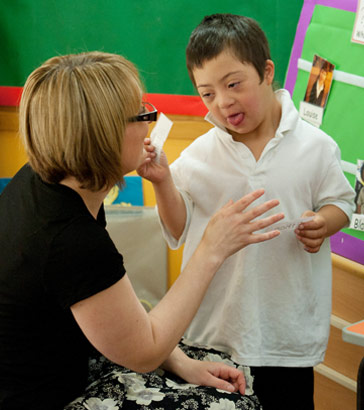
In the second stage, the class team begins to generate ways of improving the situation.
Solution-focused thinking is a useful approach to use here. In particular the use of 'the miracle question' and the 'scaling technique.

- Once the team have decided what needs to change, the question becomes how to change the child's behaviour.
- The team should decide on a 'solution' - what would the child's behaviour be like if it ceased to cause concern
- They should then decide - on a scale of 1 to 10 - where the child's behaviour is in relation to that solution
- The focus is on developing strategies to move the child up one point on the scale - not to get to a 10 of fully achieved.
- Team members should remember that, for many children, learning is a slow process and learning new behaviours requires time and energy.
- The strategy for achieving this one point change is through a process known as the 'How/How'.
- For the How/How, the solution is written in a box and the question is asked, 'How can we achieve this solution?'
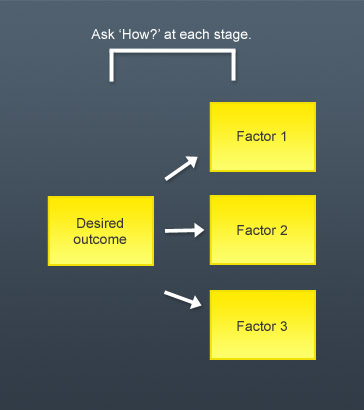
- Draw a box with the one point outcome that you are hoping for.
- Ask the team 'How can we achieve this'?
- Use the Fishbone and remind yourself of all the factors that make a difference. Consider changing some of them: what goes on in the classroom, at home, the time of day, the peer interaction, the curriculum.
- Start drawing out the How/How with each box indicating a new How.
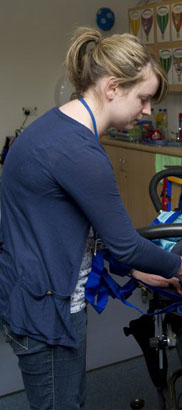
- The team decided that they needed to help Nick communicate his wants if they were to stop him screaming.
- To this end, they came up with five ideas to help develop Nick's communication - listening and looking out for cues; using picture symbols; observation; developing a routine; and using vocalisation.
- By asking 'How?' again the team generated a series of strategies related to implementing ideas they had identified, e.g. using objects of interest to cue him into sessions; using a favourite piece of cloth to encourage him to join the class group; using positive sounds about eating and drinking to encourage his interest
- Where necessary, the process can be repeated to a third and even fourth level to generate increasingly detailed and practical strategies.

- By generating a range of strategies collaboratively the team will feel more empowered
- A major issue in working with children who are distressed and whose behaviour is challenging, is that adults can feel disempowered with a situation which they feel is not within their control.
- There are different levels of control. Legally, a teacher is always responsible for the control of the class but staff also need to be in control emotionally and practically, by not letting the child's emotional distress undermine their own resilience.
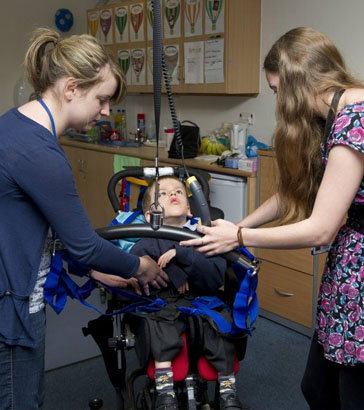
- A particular issue when using Quality Circles is that occasionally the staff team can find it difficult to think of strategies for the 'How/How'. In part, this may be related to feelings of having lost control, as mentioned above.
- The focus should be on how the team needs to change if the child's behaviour is to change. The child's behaviour will only change if the behaviour of the adults around them changes. This may be emotionally difficult for the team as they may feel it is not they who have the problem - but they do carry the solution.
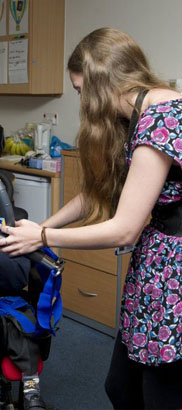
Classroom dynamics mean that the team has to keep a balance between the meeting needs of an individual child and those of other children in the class.
- Children in many special school classes have particular and complex needs and many are emotionally distressed.
- Class teams may be concerned that changing a routine or structure for one child will disrupt things for other members of the class. So, for example, although making a distraction free environment by removing the bright shiny pictures from the walls may be helpful for one child, it may also detract from the quality of the environment for other children. On balance, however, it could be decided to proceed because making this change will improve the emotional climate within the classroom, enhance the relationships between adults and children and, thus, enable learning to take place.
- It is important to take account of the emotional aspects of change and not view responding to individual needs as 'giving in'.
Signing up to a plan

- At the third stage, the team agrees a plan for how they will change classroom practice.
- This means selecting one, or maybe two, of the strategies identified by the "How/How" and agreeing who is going to apply them.
Over a six-month period the class team agreed four separate strategies for Nick. Click the button below to see how the
class team agreed and used a series of strategies to help Nick develop his communication skills.
View strategies
| STRATEGIES | TO BE APPLIED BY | START DATE |
| Nick is allowed to eat as much as he likes when he wants to eat. | Class team | 23.02.11 |
Nick will indicate that he wants crisps. When he goes to the cupboard
door:
|
Class team | 04.03.11 |
Staff are to do observations during morning breaks. These can be:
|
Class team | 04.03.11 |
| Staff to use Nick's favourite blue material to bring him to the class group and place it on his chair ready for him to sit for the start of the session | Teacher or session leader | 16.06.11 |
Return

- Quality Circles is a process where people get together in their own teams to solve problems.
- These techniques have been adapted for use with children with complex learning difficulties.
- Quality Circles does not provide a panacea for promoting positive behaviour. Instead it is offered as a way of working together to think about the problems from the child's perspective.
- Quality Circles take time to organise and run and requires a commitment by the class team and the school. The school needs to provide support and the authority for the class team to feel empowered to work together.

Arthur, A (2003) The emotional lives of people with learning disability, British Journal of Learning Disabilities,
31, 25 - 30.
Emerson, E (2003) Prevalence of psychiatric disorders in children and
adolescents with and without intellectual disability, Journal of Intellectual
Disability Research 47, 51 - 58.
Gardener, W., Graeber-Whalen, J., and Ford, D. (2001) 'Behaviour Therapies'.
In: Dosen, A and Day, K, Treating Mental Illness and Behaviour Disorders
in Children and Adults with Mental Retardation, American Psychiatric,
London 69 - 100.
Lloyd, H. and Dallos, R. (2006) Solution-focussed Brief Therapy with
Families who have a child with intellectual disabilities, Clinical
and Child Psychology and Psychiatry 11.3. 367 - 386.

Robson, M (1982) Quality Circles: A Practical Guide, Brookfield, VT: Gower.
Sterkenburg, P, Janseen, C and Schuengel C (2008) The Effect of an Attachment-Based
Behaviour Therapy for Children with Visual and Severe Intellectual Disabilities,
Journal of Applied research in Intellectual Disabilities 21 126 - 135.
Fox, M. and Laverty, T. (2009) Using Quality Circles to help think about the challenging behaviour and emotional distress
of children with severe learning difficulties. The SLD Experience, 55, 17-22.